Overview
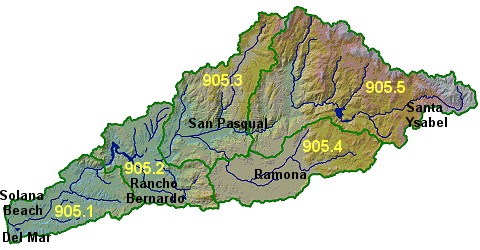
The San Dieguito River Watershed Management Area (WMA) is a drainage area that encompasses approximately 345 square miles, including portions of the Cities of Del Mar, Escondido, Poway, San Diego, and Solana Beach, and unincorporated areas of San Diego County. It lies in the west-central portion of the County and neighbors Carlsbad and San Luis Rey Watersheds to the north and Los Penasquitos and San Diego River Watersheds to the south.
The watershed can be divided into five primary hydrological areas, each with unique geological and environmental features:
- Solana Beach (905.1)
- Hodges (905.2)
- San Pasqual (905.3)
- Santa Maria Valley (905.4)
- Santa Ysabel (905.5)
Rainfall to the area primarily drains through the San Dieguito River, which stretches east to west and originates near Santa Ysabel, in the Cuyamaca Mountains. The river eventually discharges to the Pacific Ocean near the communities of Del Mar and Solana Beach.
The San Dieguito River Watershed supplies area residents with potable water sourced from several reservoirs including Lake Hodges. Currently, about sixty-one percent (61%) of the WMA remains undeveloped or has been designated as open space. The remaining thirty-nine percent (39%) of the land area is being utilized as residential areas (18%), agriculture (14%), and other (7%). For further land use breakdowns by hydrologic area, please see the hydrologic area descriptions below.
The San Dieguito River Watershed is estimated to be home to approximately 178,000 residents (2010 U.S. Census). The vast majority of the population is concentrated in the more developed urban and suburban regions of the lower watershed, in the cities of Solana Beach and Del Mar, and the unincorporated community of Rancho Bernardo. Due in part to extensive development, the lower San Dieguito River bears a disproportionate share of the pollution burden when compared to portions of the watershed upstream. The watershed suffers from several pollutants, which have the potential to negatively impact how residents, business-owners, and tourists use and interact with local water bodies.
It is important to note, however, that the watershed serves more than just humans. The San Dieguito River WMA extends through a diverse array of habitats from its eastern headwaters around the Cuyamaca Mountains to the outlet at the San Dieguito Lagoon and the Pacific Ocean. These areas help sustain a number of threatened and endangered species, including the Belding’s savannah sparrow, western snowy plover, and California least tern.
For more information about water bodies see the San Diego Basin Plan, which provides information on uses of water bodies and water quality objectives, beneficial uses and the 303(d) list, which identifies water body segments not meeting water quality standards.
Water Quality Improvement Plan (WQIP)
Agencies involved in the development of the San Dieguito Water Quality Improvement Plan (WQIP) include the Cities of San Diego, Del Mar, Escondido, Poway, and Solana Beach, and the County of San Diego. The WQIP is a requirement of updated stormwater regulations adopted by the Regional Water Quality Control Board (Regional Board) according to Order No. R9-2013-0001, as amended by Order Nos. R9 2015-0001 and R9-2015-0100. The ultimate goal of the WQIP is to protect, preserve, enhance, and restore water quality of receiving water bodies. These improvements in water quality will be accomplished through an adaptive planning and management process that identifies the highest priority water quality conditions within the watershed and implements strategies to address them.
The San Dieguito Water Quality Improvement Plan was originally submitted to the Regional Board on June 26, 2015, as required by the Municipal Permit. The WQIP was subsequently revised and resubmitted in order to incorporate comments received from the public and the Regional Board. Following further comments, the Regional Board issued an acceptance letter for the San Dieguito WQIP on February 12, 2016. The resulting WQIP, appendices, and acceptance letter are available at the links above.
2021 WQIP Update
The San Dieguito Watershed Management Area (WMA) Responsible Agencies performed an update of the San Dieguito WMA Water Quality Improvement Plan (WQIP). The WQIP update focused on the upper portions of the watershed, specifically the potential impairment of the municipal and domestic supply beneficial use at Lake Hodges Reservoir due to the presence of excess nutrients for wet and dry weather. Based on this new Highest Priority Water Quality Concern (HPWQC) designation, the Responsible Agencies developed new goals and strategies to improve overall water quality conditions. On March 29, 2021 the Regional Board accepted the 2021 WQIP Update in accordance with provision F.2.c (1)(d) and provision F.4 of the Order.
WQIP Annual Reports
The San Dieguito Watershed Management Area (WMA) Water Quality Improvement Plan (WQIP) Annual Reports allow copermittees to demonstrate progress made during the fiscal year towards achieving water quality goals. They are a direct requirement of the National Pollutant Discharge Elimination System (NPDES) Permit, Order No. R9-2013-0001, as amended by Order Nos. R9-2015-0001 and R9-2015-0100. The Annual Reports contain specific information regarding strategy implementation and monitoring efforts and data. Furthermore, they serve as a basis upon which copermittees may choose to adaptively manage their highest priorities and goals/strategies, according to the most recent water quality data.
For most San Diego Region watersheds, FY 2015-16 is the first year of WQIP implementation and is therefore the first year of annual reporting. Annual reports are submitted to the Regional Board by January 31 of the following year.
Below are the most recent annual reports, to view years prior to 2015-2016 click here.
Jurisdictional Runoff Management Plans
The Regional Stormwater Permit (Order No. R9-2013-0001, as amended by Order Nos. R9-2015-0001 and R9-2015-0100) requires that the San Diego Region Copermittees provide access to their Jurisdictional Runoff Management Program documents on a Regional Clearinghouse website. The purpose of JRMP documents are to guide implementation of programs and strategies to reduce pollutants discharged from each Copermittee’s storm drain system to receiving waters. The JRMPs for each Copermittee involved in the San Dieguito WMA are linked to below.
City of Del Mar JRMP and GIS data files
City of Escondido JRMP and GIS data files
City of Poway JRMP and GIS data files
City of San Diego JRMP
City of Solana Beach JRMP and GIS data files
County of San Diego JRMP and GIS data files
BMP Design Manuals
The Regional Stormwater Permit (Order No. R9-2013-0001, as amended by Order Nos. R9-2015-0001 and R9-2015-0100) requires that the San Diego Region Copermittees provide access to their BMP Design Manuals and associated documents on a Regional Clearinghouse website.
The BMP Design Manuals for each Copermittee involved in the San Dieguito WMA are linked to below:
City of Del Mar
City of Escondido
City of Poway
City of San Diego
City of Solana Beach
County of San Diego
Model BMP Design Manual
The San Diego County Copermittees developed a Model BMP Design Manual for the San Diego Region in order to conform to updated development requirements of the 2013 Municipal Storm Water Permit (Order No. R9-2013-0001, as amended by Order Nos. R9-2015-0001 and R0-2015-0100). The Model BMP Design Manual provides procedures for planning, selecting and designing onsite structural BMPs for new development and significant redevelopment projects in accordance with the 2013 Municipal Permit. Additionally, the Regional Manual provides a basis for the development of local BMP Design Manuals by each Stormwater Copermittee in the San Diego region.
Each Copermittee was required to update its local BMP Design Manual in accordance with the content of the regional model on or before the February 16, 2016 deadline outlined in the 2013 Permit.
The final model BMP Design Manual, its appendices, and associated materials can be retrieved here:
Other Plans and Projects
Additional plans and projects not necessarily associated with the Water Quality Improvement Plan (WQIP) are listed below.
Transitional Monitoring and Assessment Program Report (TMAR)
A requirement of the Municipal Permit Order No. 2013-0001 (as amended in Order Nos. R9-2015-0001 and R9-2015-0100), transitional monitoring was conducted and reported on prior to development of the San Dieguito WQIP. The reports, appendices, and associated documents can be found below:
Things To Consider
When excessive quantities of pollutants are deposited into these water bodies, they may inhibit many or all of these beneficial uses and can result in actions such as beach closures and postings. The majority of pollutants impacting the San Dieguito WMA are attributed to urban runoff, agricultural runoff, and domestic animals.
Under Section 303(d) of the Clean Water Act, several water bodies within the San Dieguito River WMA were identified as impaired (see 303(d) table above). These impairments are required to be addressed through a number of best management practices and regular monitoring. As such, copermittees (also referred to as Responsible Agencies (RAs)) focus their treatment and cleanup efforts on these water quality conditions.
Additionally, copermittees are required to develop a comprehensive Water Quality Improvement Plan (WQIP) for the WMA that identifies highest priority water quality conditions, strategies to address them, and monitoring plans. The WQIP and associated Annual Reports are required by the Regional Water Quality Control Board Order No. R9-2013-0001 as amended by Order Nos. R9-2015-0001 and R9-2015-0100 and pertain specifically to improving the quality of both storm water and non-storm water discharged by copermittees’ municipal separate storm sewer systems. The WQIP for the San Dieguito River WMA was submitted to and received approval from the Regional Water Quality Control Board in February 2016. Copermittees within the San Dieguito River WMA selected indicator bacteria in the San Dieguito River above and below Lake Hodges Reservoir as their highest priority water quality condition.
Hydrologic Area (HA) Descriptions
Solana Beach HA (905.1)

San Dieguito Lagoon – https://jamescoffeestudios.smugmug.com/Panoramas/San-Dieguito-River-Park/i-8VLTMjZ/A (Credit, James Coffee)
Stretching from the Hodges Dam in the east to the Pacific Ocean in the west, the Solana Beach Hydrologic Area covers an area of about 31,000 acres. The most populated system within the WMA, it is also divided between the highest number of copermittees when compared to its counterparts. As such, jurisdiction over its municipal separate storm and sewer system is shared between the County of San Diego and the Cities of Solana Beach, Del Mar, and San Diego.
Where the San Dieguito River meets the Pacific Ocean lies San Dieguito Lagoon, a 150 acre estuary that recently underwent an extensive wetland restoration project aimed at improving water quality and reviving native species habitat. Similar to many of the wetland habitats in the San Diego region, the San Dieguito Lagoon provides refuge to a number of threatened and endangered bird species, including least terns and the Belding’s savannah Sparrow.
As a result of land disturbances in the area upstream, the lagoon has seen increased rates of sedimentation due to erosion. Currently, land use in the Solana Beach system is distributed accordingly: forty-four percent (44%) open space and undeveloped land, twenty-nine percent (29%) residential, eleven percent (11%) transportation, and ten percent (10%) agriculture. The remaining land area contains industrial, commercial, and other uses.
Partially due to heightened rates of sedimentation, there exists a delicate balance involved in maintaining water quality standards in San Dieguito Lagoon. When tidal flushing becomes restricted, pollutants have the tendency to collect in the Lagoon and can negatively impact water quality. As such, the Pacific Ocean near the mouth of the San Dieguito Lagoon has been listed as impaired for excessive concentrations of total coliform bacteria under Section 303(d) of the Clean Water Act. The San Dieguito River is also listed for fecal coliform bacteria, Enterococcus bacteria, nitrogen, phosphorus, total dissolved solids, and aquatic toxicity.
Hodges HA (905.2)
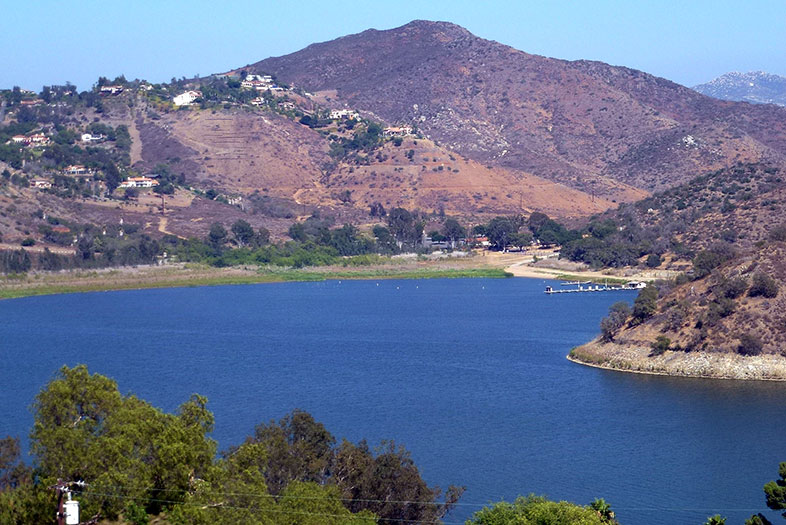
Lake Hodges – http://palomaraudubon.org/events/lake-hodges-field-trip/
Terminating at the Hodges Reservoir, the Hodges Hydrologic Area encompasses a land area of over 30,000 acres. Similar to the Solana Beach system, it is divided between several jurisdictions; namely, the County of San Diego and the Cities of Escondido, Poway, and San Diego.
The Hodges system includes a number of water bodies, such as Felicita Creek, Kit Carson Creek, and Lake Hodges Reservoir. Hodges Reservoir, which was expanded in 1918 to become the largest lake in the WMA, supplements other sources to supply water to residents and businesses in the San Diego region.
Land use in the Hodges Hydrologic Area mirrors that in Solana Beach, with open spaces and undeveloped lands constituting forty-four percent (44%) of the sub-watershed area. Residential areas are the second most common land use, accounting for thirty-six percent (36%) of the hydrologic area. Transportation is another significant land use, followed by several miscellaneous uses.
Several water bodies within the Hodges system have been listed as impaired under Section 303(d) of the Clean Water Act. This list includes Lake Hodges, which has been recognized as being affected by mercury, nitrogen, phosphorus, manganese, turbidity, and pH, among other pollutants. Felicita Creek is also considered impaired for total dissolved solids and aluminum.
Hodges HA (905.2)

Lake Hodges – http://palomaraudubon.org/events/lake-hodges-field-trip/
Terminating at the Hodges Reservoir, the Hodges Hydrologic Area encompasses a land area of over 30,000 acres. Similar to the Solana Beach system, it is divided between several jurisdictions; namely, the County of San Diego and the Cities of Escondido, Poway, and San Diego.
The Hodges system includes a number of water bodies, such as Felicita Creek, Kit Carson Creek, and Lake Hodges Reservoir. Hodges Reservoir, which was expanded in 1918 to become the largest lake in the WMA, supplements other sources to supply water to residents and businesses in the San Diego region.
Land use in the Hodges Hydrologic Area mirrors that in Solana Beach, with open spaces and undeveloped lands constituting forty-four percent (44%) of the sub-watershed area. Residential areas are the second most common land use, accounting for thirty-six percent (36%) of the hydrologic area. Transportation is another significant land use, followed by several miscellaneous uses.
Several water bodies within the Hodges system have been listed as impaired under Section 303(d) of the Clean Water Act. This list includes Lake Hodges, which has been recognized as being affected by mercury, nitrogen, phosphorus, manganese, turbidity, and pH, among other pollutants. Felicita Creek is also considered impaired for total dissolved solids and aluminum.
San Pasqual HA (905.3)
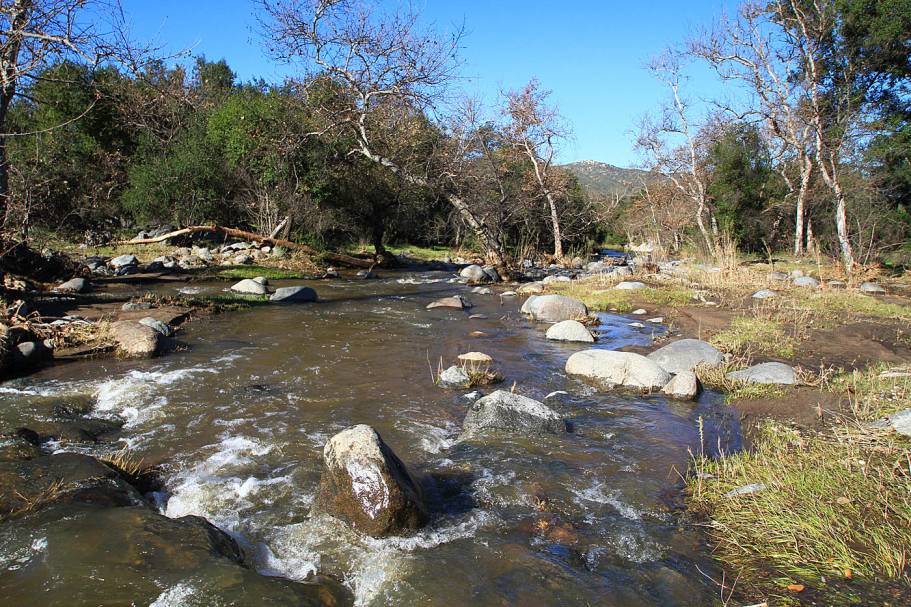
Santa Ysabel Creek – http://www.mountainbikebill.com/blog/?p=763
The San Pasqual Hydrologic Area is approximately 43,400 acres in size and makes up roughly twenty percent (20%) of the San Dieguito River WMA. The drainage basin lies within the jurisdictions of the Cities of Escondido, Poway, and San Diego, as well as the County of San Diego.
Land area of the San Pasqual Hydrologic Area is divided amongst open spaces and undeveloped lands (64%), agriculture (26%), residential (8%), and other land uses.
The majority of surface runoff to the region enters the Santa Ysabel Creek. However, there are also a number of smaller tributaries that feed into the creek, including Guejito Creek, Rockwood Canyon Creek, and Cloverdale Creek in San Pasqual Valley. One of these water bodies, Cloverdale Creek, has been listed as impaired under Section 303(d) of the Clean Water Act for total dissolved solids and phosphorus levels.
Santa Maria Valley HA (905.4)
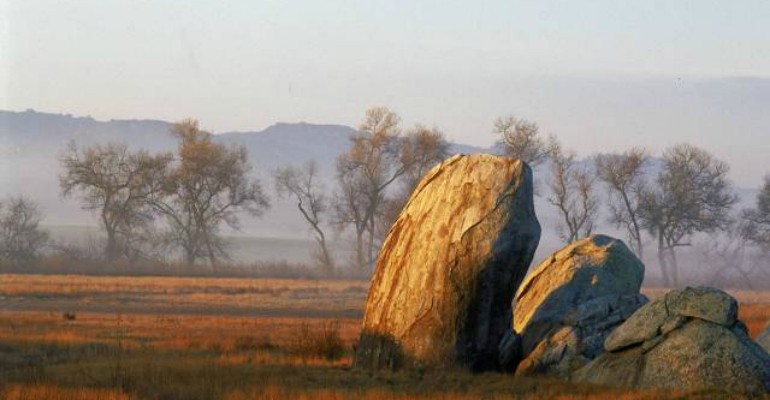
Ramona Grasslands Preserve – http://www.sdparks.org/content/dam/sdparks/en/images/park-images/RamonaGrasslands_1.jpg/_jcr_content/renditions/cq5dam.web.1280.1280.jpeg
At roughly 37,000 acres, the Santa Maria Valley Hydrologic Area constitutes about seventeen percent (17%) of the San Dieguito River WMA. As the sole jurisdiction in the sub-watershed, monitoring and inspections of the area municipal separate storm and sewer systems falls entirely to the County of San Diego.
Primary water bodies within the system include Santa Maria Creek and Hatfield Creek. Most surface runoff is directed into one of these creeks and later enters the San Pasqual Hydrologic Area downstream.
The Cleveland National Forest, a 460,000 acre National Forest is located partially within the boundaries of the hydrologic area and contains a number of sensitive plant and animal species. Also located within the system is the Ramona Grasslands Preserve.
Here, open space and undeveloped lands constitute forty-one percent (41%) of its land area, followed closely by residential lands at thirty-five percent (35%) and agricultural lands at eighteen percent (18%).
Santa Ysabel HA (905.5)
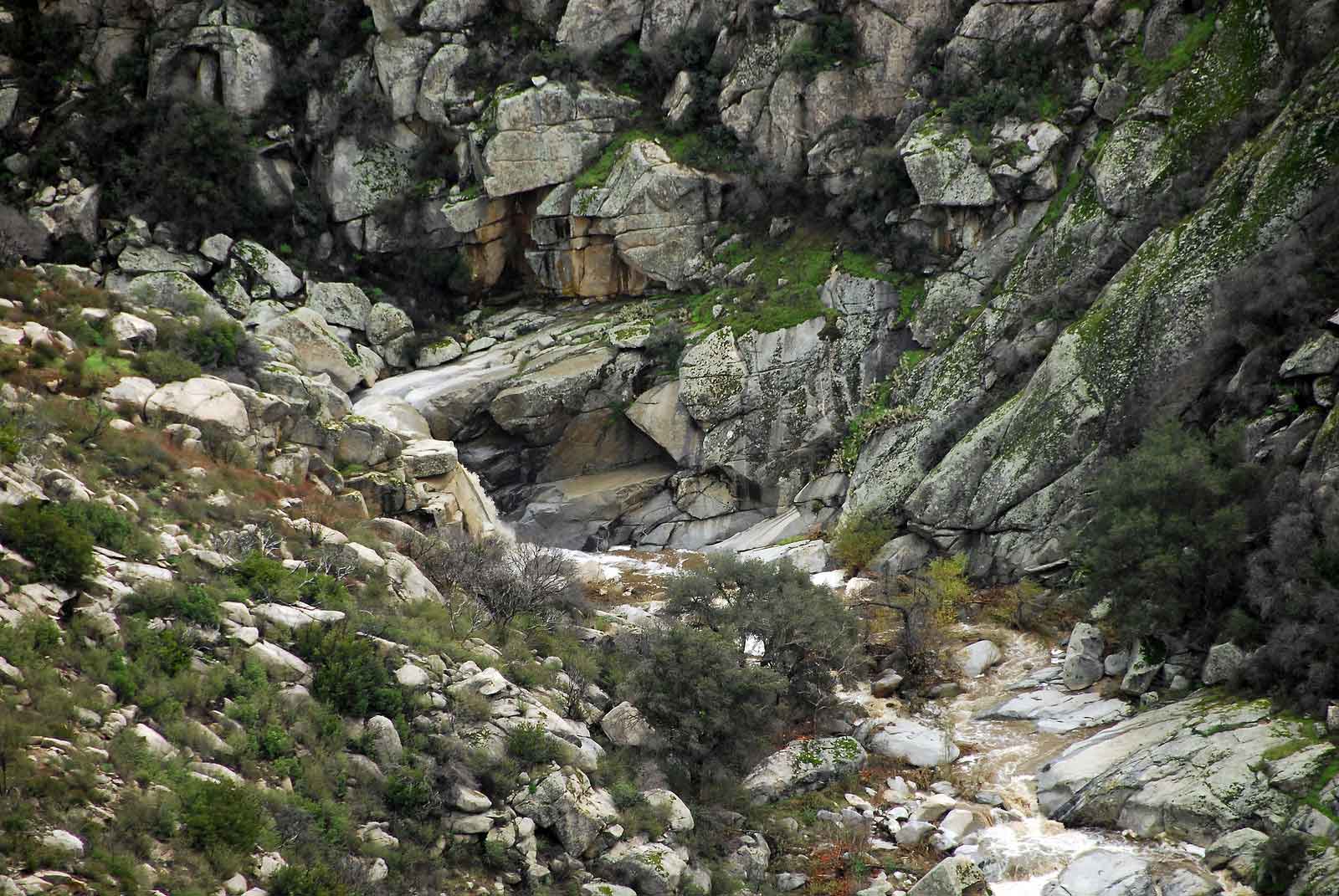
Santa Ysabel Creek (Above Sutherland Lake) – https://jamescoffeestudios.smugmug.com/San-Dieguito-River-Park/Image-Stock/Aerial/20101223-Helicopter-Lake/i-Tm4z8HH/A (Credit, James Coffee)
Far exceeding its counterparts in land area, the Santa Ysabel Hydrologic Area is approximately 82,000 acres in size. Although the County of San Diego has been named the sole copermittee for the system, the area also contains a considerable share of federal and state owned land and is home to a number of Indian Reservations. These lands are not subjected to the same requirements that local governments must adhere to, and therefore lie outside of the jurisdiction of the County of San Diego.
As the easternmost hydrologic area within the San Dieguito WMA, the system begins in the Volcan Mountains at the headwaters of Santa Ysabel Creek. Surface water is subsequently directed westward and is captured and consolidated behind the Sutherland Dam. Here, the Sutherland Reservoir isolates waters of the Santa Ysabel Hydrologic Area from water bodies situated in other hydrologic areas downstream, effectively cutting it off from the remainder of the WMA.
An immense range of endangered plant and animal species have been discovered in the Santa Ysabel Hydrologic Area. Twenty-two (22) were observed in the Cleveland National Forest, a 460,000 acre National Forest that lies partially within the Santa Ysabel system.
Lacking significant urbanization, open spaces and undeveloped land comprise roughly eighty-three percent (83%) of the Santa Ysabel Hydrologic Area. Remaining land in the system is dedicated to other uses, including agricultural (12%) and residential (4%) land uses.
Despite its lack of development, several water features within the Santa Ysabel system suffer from impairments. Santa Ysabel Creek, for example, is listed as impaired as a result of aquatic toxicity under Section 303(d) of the Clean Water Act. Also on the list is Sutherland Reservoir, which is impacted by a low pH and unexpectedly high concentrations of nitrogen, manganese, and iron.
The Cleveland National Forest, a 460,000 acre National Forest is located partially within the boundaries of the hydrologic area and contains a number of sensitive plant and animal species. Also located within the system is the Ramona Grasslands Preserve.
Here, open space and undeveloped lands constitute forty-one percent (41%) of its land area, followed closely by residential lands at thirty-five percent (35%) and agricultural lands at eighteen percent (18%).